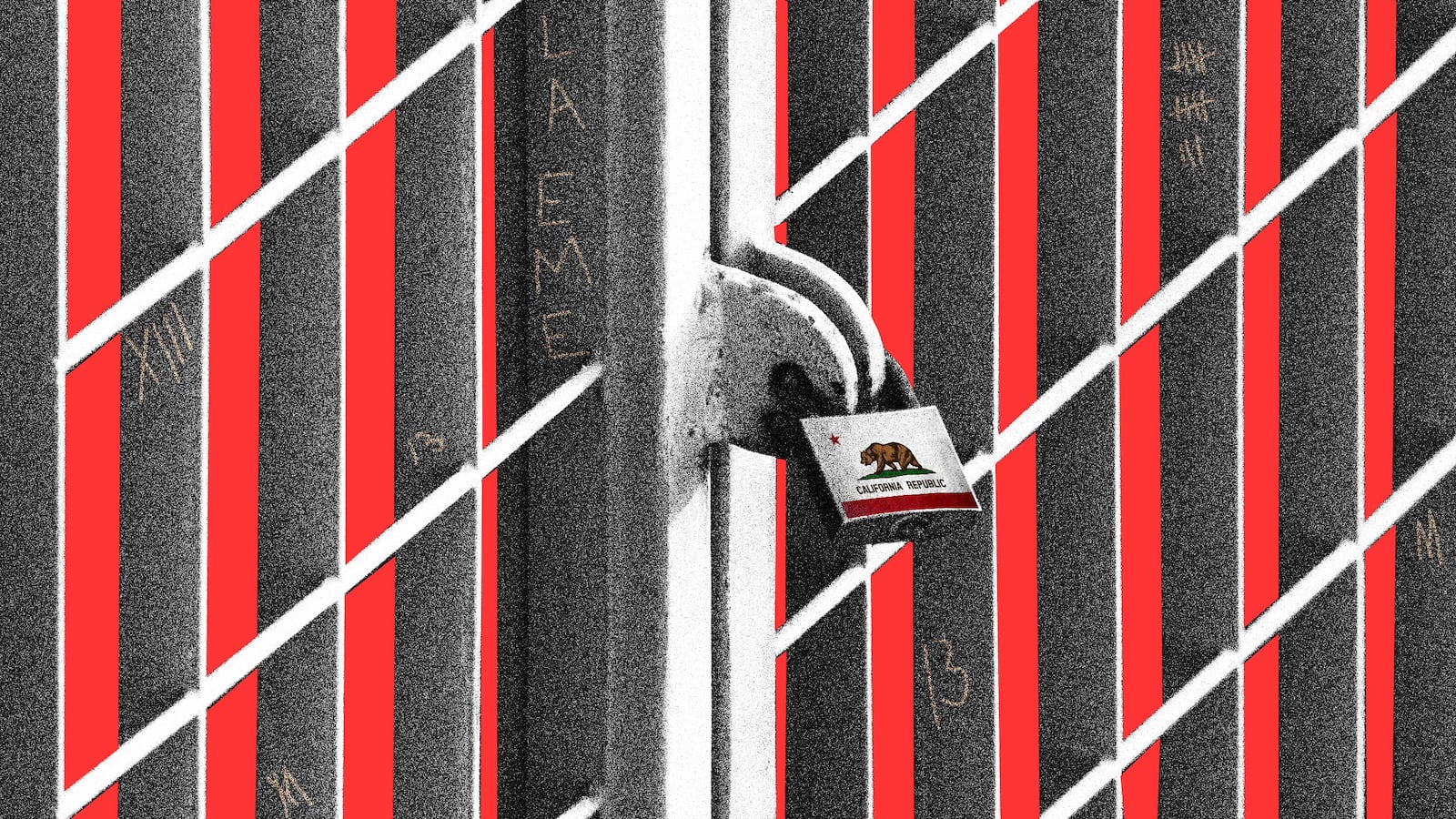To the jailers of California, the Mexican Mafia is known as the gang of gangs.
Any member of a Latino street gang sent to prison or jail in California likely has to abide by the rules and dictates of the gang while in prison.
Even to the point of making peace with their long-time hated rivals.
“They have the ability to turn gangs that are historically sworn enemies that fight on the streets into allies when they come inside our jail system,” said Commander Joseph Dempsey of the Los Angeles County Sheriff’s Department.
Author and former Los Angeles Times reporter Sam Quinones has chronicled the Mexican Mafia and associated Latino street gangs of California for two decades. Quinones says the gang’s power extended as its 30-year reputation for viciousness in the jail system won the allegiance of Latino street gangs throughout Southern California.
“The Mexican Mafia’s influence and importance to Southern California goes far far beyond the prisons now,” Quinones told The Daily Beast. “I came to understand the Mexican Mafia was as important to many towns and communities as the mayor. They had an enormous effect in certain areas of Southern California, particularly the Latino barrios—an effect on the crime rate, the murder rate, and how drugs were sold.”
Two federal indictments unsealed May 23 in Los Angeles vividly affirm the immense power wielded by the gang of gangs in the jails and prisons of California.
The court documents allege members of the Mexican Mafia divided up control of the drug trade in nearly every jail and prison in the state, imposing “taxes” and meting out violent discipline to inmates who didn’t follow the gang’s rules.
One of the indictments goes as far as to characterize the gang’s activity as “an illegal government” inside what is the largest jail system in the country.
What’s more, the indictments assert what cops and crooks in Los Angeles have been saying for years, that the gang’s system of discipline and “taxation” extended far beyond the walls of the state’s prisons and into nearly every community in the Los Angeles area where Latino street gangs were active.
“Members of such gangs are expected to, and are proud to, carry out the orders of the Mexican Mafia member in control of their neighborhood or custody facility, because doing work for the Mexican Mafia increases the gang member’s status and reputation,” reads one of the unsealed indictments.
A sense of the far-reaching criminal enterprise in Southern California was evident from the array of local police and federal agents who participated in last week’s announcement that federal racketeering charges were being brought against Mexican Mafia members and associates.
There was David J. Downing, DEA special agent in charge of Los Angeles; Paul Delacourt, FBI assistant director in charge of Los Angeles; Nick Hanna, U.S. attorney; and officials from Los Angeles, including County Sheriff Jim McDonnell, City of Pomona Police Chief Michael Olivieri, and officials from Homeland Security Investigations and the California Department of Corrections and Rehabilitation.
“There were a lot of different agencies involved,” Commander Dempsey of the L.A. County Sheriff’s Department said. “It comes with the nature of the Mexican Mafia’s operation, where it’s not just involved in jails and prisons. Their influence goes out into the streets and communities.”
Earlier that day, hundreds of police and federal agents had taken part in coordinated arrests, taking into custody 32 people who are charged in the indictments, according to the U.S. attorney’s office. An additional 35 people charged in the indictments were already in custody in state prisons or county jails. They are being housed in a federal jail, according to a spokesperson for the U.S. attorney’s office. Authorities said they are continuing to search for 16 people charged in the indictment who remain at large.
“I won’t say we dismantled them by any stretch of the imagination,” Dempsey said. “But it definitely puts a dent in their operation.”
The two indictments, part of a three-year investigation, charge a total of 83 people as part of a criminal conspiracy that involved murder, kidnapping, robbery, extortion, drug trafficking, witness tampering, money laundering, and identity theft.
“The Mexican Mafia appears to be the most powerful prison gang in California,” Thom Mrozek, spokesperson for the U.S. attorney’s office, told The Daily Beast. “It wields considerable influence over many Hispanic street gangs in Southern California.”
The Mexican Mafia is often referred to as La Eme, Spanish for the letter M, which is the 13th letter of the alphabet. Mrozek said that the Mexican Mafia’s scope and power are reflected in the fact that a number of gangs demonstrate allegiance to the group by adding a “13” to their names, including MS-13.
Altogether, the court filings in the case lay out an elaborate system in which gang members rely on trusted associates to carry out orders and manage the criminal enterprise.
Full members of the Mexican Mafia, known as carnales or “brothers,” are relatively few; the indictment estimates there are only about 140, most of whom are incarcerated in prisons or jails in California. To become a Mexican Mafia member requires establishing a reputation for “putting in work” for the gang, which, according to the indictment, means a demonstrated willingness to murder or assault gang enemies, provide financial assistance to gang members, and follow gang rules inside and outside of prison.
To exercise their power in prisons, they rely on subordinates, including trusted lieutenants known as shot-callers, and messengers, enforcers, smugglers, and money launderers.
The first indictment unsealed in Los Angeles alleges that a select few incarcerated members of the Mexican Mafia, led by 55-year-old Jose Landa-Rodriguez, divided up control of nearly every jail and prison in California, and functioned as “an illegal government” inside the L.A. County jail system, which houses around 15,000 inmates on a daily basis.
Landa-Rodriguez is accused of carrying out a host of criminal activities including authorizing murders, assaults, and the kidnapping and planned murder of the relative of a gang member who had defied him.
A second Mexican Mafia member, Luis Vega, 33, is charged with having ordered a murder and directed assaults against gang associates who showed disrespect or failed to follow Mexican Mafia rules. According to the indictment, Vega used secret handwritten messages, known as a “kites,” to order that a gang associate be stabbed 13 times as discipline for supposedly disrespecting Vega.
These are but a few of the hundreds of crimes alleged in the government’s case.
A second indictment targets Michael “Pomona Mike” Lerma, an alleged gang member accused of running criminal rackets with an iron fist in the city of Pomona.
The indictments go into details seemingly made for a TV prison drama. They explain how gang members during the period of the investigation allegedly used wives and girlfriends and other influential women, referred to as “secretaries,” as go-betweens to transmit orders regarding discipline and other sensitive information. One defendant named in the indictment is a lawyer accused of using his attorney-client privilege to convey messages and orders related to the gang’s criminal activity.
The jail indictment lists numerous instances in which trusted gang associates allegedly smuggled cocaine, methamphetamine, and heroin by the ounce into jails and prisons. It also explains other systems of “taxation” behind bars, including one alleged extortion scheme in which “all Latino inmates were required to contribute a percentage of their commissary spending on food and hygiene items into a ‘kitty’ that generated additional income for the Mexican Mafia member when the kitty was sold to an inmate.”
The court filings say that in the gang’s prison hierarchy, Latino inmates are divided into three categories: Sureños, a term for Latino gang members loyal to the Mexican Mafia; Paisas, Mexican nationals who have no gang affiliation; and Residents, who are of Latin American descent and, like Paisas, have no prior gang affiliation.
The name of the federal investigation, Operation “Dirty Thirds,” was taken from an alleged practice of the Mexican Mafia to collect a “thirds” tax on all drugs smuggled in L.A. County jails. According to the indictment, it meant that one-third of all illegal drugs smuggled into jails or prisons had to be “broken off” and given to the senior Mexican Mafia member or shot-caller in charge. Such was the extent of the gang’s power that if the Mexican Mafia member in charge decided to sell the “thirds-tax” portion of the drugs, other inmates were barred from selling drugs of their own until the member’s drugs were completely sold.
Quinones has interviewed dozens of Sureños. He even met “Pomona Mike” Lerma on a reporting trip to Pelican Bay State Prison. “He was cooking cocoa on his little hot plate in the cell,” Quinones recalled. “Seemed nice enough. He was about 5’4” and wan, almost pale. They get very little sun.”
Quinones says the Mexican Mafia began somewhat modifying the way it operated about 10 years ago, ordering associates to keep a lower profile in the L.A. area—less violence, lower visibility—and focus instead on growing the lucrative income from drug-trafficking and identity theft.
“These gangs have become business entities more than what they were for years, which was defenders of turf, which terrified and blighted a whole region and was a huge problem for decades,” Quinones said.
He says a federal crackdown like the one announced last week shows that despite the gang’s lower profile on the streets, La Eme remains a powerful force, especially in Southern California.
“On the one hand, they don’t exist because you go around these neighborhoods and you don’t see them anymore. It doesn’t mean they aren’t still active.”






